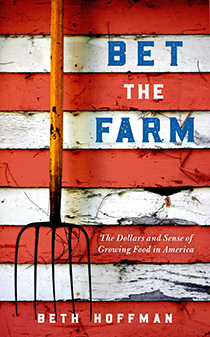Review of: “Bet The Farm: The Dollars and Sense of Growing Food in America”
“Bet The Farm: The Dollars and Sense of Growing Food in America,” by PFI member Beth Hoffman, is an in-depth look at the economic challenges of starting a farm through the eyes of a journalist who has recently transitioned into farming.
 This topic spoke to me personally, since I also became a beginning farmer later in life. The book touches on questions I have also pondered, such as how do we create a self-sustaining, socially and environmentally sound business – and is it possible?
This topic spoke to me personally, since I also became a beginning farmer later in life. The book touches on questions I have also pondered, such as how do we create a self-sustaining, socially and environmentally sound business – and is it possible?
Beth wrote about food and agriculture for 25 years before making the leap into living the life she had previously only written about. In 2019, Beth and her husband, John Hogeland, moved from San Francisco to John’s family farmland in Iowa, onto a part of the farm that has been in John’s family since the late 1850s. She acknowledges the privilege of entering their new endeavor with a leg up: a healthy nest egg and direct access to generational family land. Many beginning farmers do not have these resources to fall back on, and often don’t have the same latitude when making business decisions.
Early on, we learn of John’s family history spanning five generations on the land, as well as the challenging conversations that come with transferring land and forging a new, unconventional path. Ultimately, the couple signed a lease with John’s father and created Whippoorwill Creek Farm on a 530-acre tract near Lovillia, in south-central Iowa, with plenty of land to improve.
Beth shares the challenges of transitioning the land to organic production. They encountered obstacles common to new (and experienced) farmers – purchasing the proper oat seed, using the right planting methods, unpredictable weather and market uncertainties among them. Readers also learn about the difficult path farmers must navigate through government programs to access resources.
Beth and John start their grass-fed beef business by leasing cattle from John’s dad, and Beth shares how they must delve into the business of raising cattle for market. John’s background as a butcher equipped him with knowledge of the qualities of a fine cut of meat, but not for the challenges of marketing, processing and distributing that meat onto customers’ plates.
Beth later points out that the mechanization of farming historically has not only made farming more efficient but also enabled members of the farm family to seek work off the farm. She cites U.S. Department of Agriculture data indicating a high number of farms have at least one member engaged in off-farm jobs. In fact, until recently, my husband and I were in that category ourselves, with his “job in town” providing both health insurance and a steady income. While such benefits can provide greater stability, having more farmers on site allows for increased collaboration. It also offers the chance to strengthen infrastructure and perhaps scale up farm offerings to become more sustainable.
 The book goes on to challenge some myths about farming in an effort to find solutions to the myriad trials farmers face. In doing so, Beth addresses the importance of maintaining one’s mental health, self-care and being more mindful of daily time allocations. While farming rarely lends itself to being a 9-to-5 endeavor, I agree that it’s important to identify your farming goals and focus on moving towards them.
The book goes on to challenge some myths about farming in an effort to find solutions to the myriad trials farmers face. In doing so, Beth addresses the importance of maintaining one’s mental health, self-care and being more mindful of daily time allocations. While farming rarely lends itself to being a 9-to-5 endeavor, I agree that it’s important to identify your farming goals and focus on moving towards them.
Beth and John also search for ways to remove the hurdle of land access for new farmers, including those who are Black, Indigenous, Latino or other farmers of color. She interviews Iowans engaged in that process, learns there are barriers to climb beyond offering a piece of land and raises some important questions. For instance, how do we make those opportunities long-term or dismantle the other barriers to lasting success? How might farmers join or create cooperatives to benefit (rather than competing with) one another?
Beth also suggests we get involved at some level to drive policy changes and put more programs in place to help farmers get started. For example, farmers deserve affordable health care and greater access to high-speed internet. With fundamental improvements like these, our rural communities can become more vibrant, diverse and desirable places to live and work.
Beth’s research, coupled with her first-hand experience, takes readers on an exploration of the history of farming to better understand how we got where we are today. She doesn’t pretend to have solutions to the challenges we face but does give readers food for thought. Whether you are a farmer or an eater, I recommend this quick, thought-provoking read. “Bet The Farm” challenges us all to think about our roles in a more just and sustainable food system, many of which Practical Farmers of Iowa also promotes by facilitating conversations and creating diverse programming.
Susan Kasal Young and her husband, Rich Young, started Lucky Star Farm in 2011 on the outskirts of Iowa City, Iowa. The 20-acre farm includes pasture-raised eggs, turkeys for the holidays, Nigerian dwarf goats, occasional public goat yoga sessions and a small herd of llamas. In 2020, the Youngs completed a renovation of the 1950s-era milk house on their farm, converting it to a farm-stay Airbnb.
